Fredrick the Great is credited with saying, “Artillery adds dignity to what would otherwise be an ugly brawl.” No one will ever render a similar opinion regarding the fighting-shotgun. Terminal effects of buckshot and slugs are distinctly undignified; in fact they’re so brutal that the German Government in World War One protested that the American’s “Trench Guns” (short barreled Winchester Model 97’s) violated the Hague Convention protocols by causing “unnecessary suffering.” Ironically, contemporary trends have shown police departments largely abandoning the shotgun in preference to the carbine with civilians similarly inclining toward the use of the carbine for home defense. There’s certainly nothing wrong with the carbine for personal defense, in fact Jeff Cooper once said that the rifle is “the queen of personal weapons.” That being the case, the fighting-shotgun has become the red-haired stepchild of personal weapons. Ask anyone in the firearms-training industry and they’ll almost certainly admit that they conduct 3 or 4 rifle/carbine classes for every shotgun class that they offer. (A quick count on their websites show that Gunsite offers almost 6:1 rifle/carbine to shotgun offerings while Thunder Ranch has a 4:1 offering). There are undoubtedly several reasons for those ratios, public demand being a paramount one, however availability of qualified experts with the bona fides and enthusiasm to teach the fighting-shotgun may also be a contributing factor. There are simply more masters of the handgun and rifle/carbine than there are masters of the fighting-shotgun.
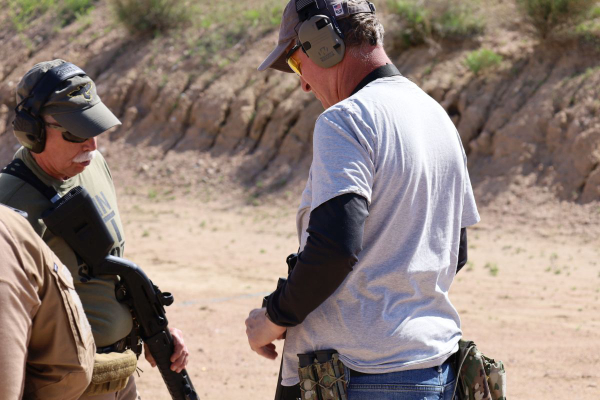
Enter Randy Watt, master of the fighting shotgun. Rather than outline an exhaustive bio here, google him. The “Cliff Notes” version is that he served for 36 years with the Ogden, Utah Police Department, retiring as Chief of Police. Along the way he served on their SWAT team for 13 years, was their lead firearms instructor and twice was awarded their Medal of Valor. After 34 years Watt also retired from the U.S. Army and Utah Army National Guard with the rank of Colonel. During his service he commanded the 19th Special Forces Group, had multiple deployments during the GWOT, trained worldwide with foreign Special Operation Forces and instructed for the Special Forces Advanced Urban Combat Course. He’s the only man that I personally know that has won 4 Bronze Stars! Randy is EXACTLY the type of man that Jeff Cooper wanted as an adjunct instructor at Gunsite, (men who, in Jeff’s words, had “seen the elephant”) so it should come as no surprise that he is one of Gunsite’s most popular instructors. His mastery of the shotgun was gained empirically on the streets of Ogden as well as the alleys of Fallujah and the caves of Afghanistan. In short, he’s what young boys of my generation wanted to become and old men wished that they’d been.
I was fortunate to sit in on a two-day fighting-shotgun class which Watt recently conducted at the Great Guns Shooting Complex in Nunn, Colorado. I found the class to be a unique combination of fighting mindset, legal justification, and firearms manipulation,
Fighting Mindset
Due to Watt’s background, he possesses personal anecdotes of a severity that few other instructors can bring to the classroom. For those of you old enough to have ever spent time with the late Jim Cirillo, you know how effective relating a personal experience of armed conflict can be in cementing a point with students. In that regard, Watt is “Cirillonian” (a word I may trademark) in his instruction. After a few short examples of “having been shot at without result,” (to quote Winston Churchill) and relating a few examples of having shot at adversaries WITH result, Watt made the statement, “I have a PhD. in violence, I don’t like stepping off the firing line without being ready for the next fight because you never know when a fight is coming.” Since he runs a hot range, Watt doesn’t tell students to “load and make ready.” At the end of a drill or shooting exercise, he simply says, “prepare for the next fight.” Should a student attempt to begin a subsequent drill with an empty chamber or unloaded magazine tube, Watt simply provides a subtle pause to let them bask in the embarrassment of their unpreparedness. His is a poignant kindness.
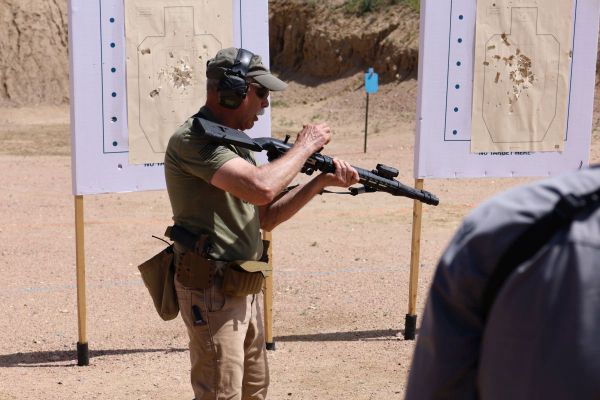
Legal Justification
While God and your conscience will dictate your moral justification in shooting a perpetrator, the state will dictate your legal justification in doing so. Today, almost everyone has a cell phone capable of taking video; virtually everything that you do in public can be recorded and easily taken out of context. That means that perception is more important than reality when attempting to convince a jury of your justification in using your weapon. Watt makes the point that seemingly little things, like your ready position, can be perceived as offensive versus defensive and hence be used against you in a trial. “Low ready” has traditionally described a position where the muzzle is pointed near the feet of the threat. Watt teaches a “very low ready” position holding the muzzle about half way between your feet and the threat. That way there’s little chance that a jury could assume that you were inappropriately pointing the shotgun at the threat when they see the video taken by a well-meaning bystander. Watt makes the point that should you need to actually shoot the threat, the time used to move the muzzle that extra distance is irrelevant. When I got home, using an electronic timer, the difference in hitting a steel silhouette from the “traditional” low ready and Watt’s “very-low” ready averaged .03 second. While the time difference is insignificant, the difference in appearance to a jury would be very significant.
Under the category of “Legal Justification,” another point that Watt makes is that your ability to assess a threat with speed while under duress will dictate whether you’re legally justified in brandishing, pointing and/or shooting. What’s often overlooked is that assessment is also necessary to determine when to STOP shooting. Determining when a threat ceases to be a threat requires accurate input. According to Watt, it takes the brain approximately .4 second to accept and assess information. In today’s competitive shooting arena, it’s not uncommon to have competitors shoot strings of fire with splits (the measured time between individual shots) under .15 of a second. (The blink of an eye is approximately .3 sec.). At that rate of fire, it’s physically impossible to assess the termination of a threat prior to shooting excess rounds. It’s not uncommon to experience a “magazine dump” (quickly shooting all of the cartridges in the magazine in one protracted string of fire) during an altercation. Not all of those projectiles are going to hit the intended target, and if they did, a case of “excessive force” will probably ensue. As Clint Smith says, “Every bullet that you shoot has a lawyer attached to it.” Therefore, all of the projectiles from the magazine dump that don’t hit the threat represent a legal vulnerability. While with the Ogden PD, Watt trained the officers to shoot 2 or 3 shots and then break and assess prior to additional shooting. As a result, the Ogden PD had an average hit rate of 68% while the national law enforcement average was 23% and the NYPD was 13%. During the shooting drills that Watt conducted, the concept of “shoot and assess” was frequently reinforced.
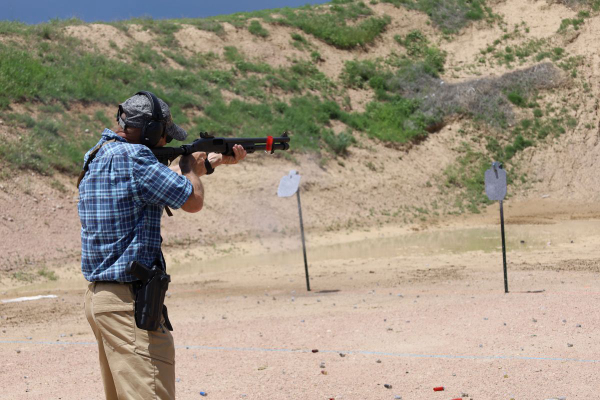
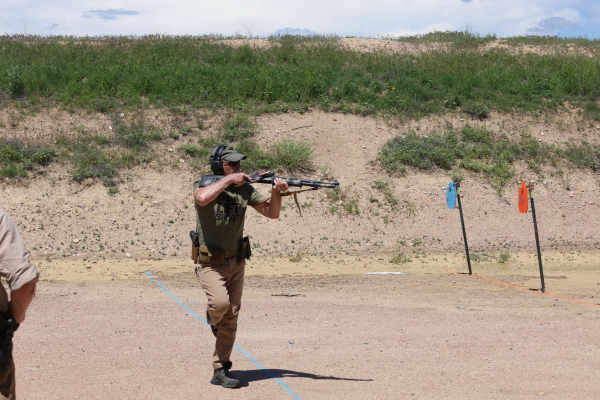
Firearms Manipulation
Semi-automatic shotguns have eclipsed the once ubiquitous pump gun in popularity for self-defense. Both have their own distinct manual of arms which poses a challenge when instructing, therefore Watt taught shotgun manipulation techniques by demonstrating with both a Beretta 1301 and a Remington 870.
To subdue the substantial recoil of buckshot and slug loads, Watt teaches his students to mount the gun pulling it back into the shoulder with the dominant hand’s grip on the pistol grip while simultaneously pushing forward, away from the shoulder with the support hand on the fore end. This should be done with enough force that the shooter feels like they are going to tear the gun in half. This is a deviation from standard doctrine on how to hold and shoot a long gun for almost everyone, and the first time the technique is tried it feels unnatural. It is however, extremely effective as Watt demonstrates shooting repeated shots from both the shoulder and the hip while exerting forward pressure with the leading, support hand on the fore end. Muzzle and rearward movement of the gun is almost nil.
For “speed reloads” and immediate action (malfunction) maneuvers Watt breaks from conventional teaching. He doesn’t use the commonly accepted terms of “speed reload” and “tactical reload,” referring to them instead as the more depictive “port reload” and “tube reload.” Traditional standard operating procedure for these manipulations dictates that the dominant hand never releases its grasp of the pistol grip, securely holding the butt of the shotgun firmly in the firing position at the shoulder. With an autoloader, orthodox technique for clearing a malfunction has the shooter tilt the shotgun so that the ejection port is facing downward while the support hand reaches under the action, works the bolt handle to the rear ejecting the bad cartridge. The support hand next secures a fresh round, and while reaching underneath the action inserts it into the open ejection port, hits the bolt release button and returns to the fore end prior to the resumption of shooting. According to Watt, that technique is placing too much confidence in the support hand’s dexterity. The dominant hand is stronger, more dexterous, and better equipped to successfully execute fine motor skills. Watt’s technique is to leave the support hand gripping the fore end holding the shotgun with the butt remaining firmly against the shoulder. The dominant hand releases the pistol grip, works the bolt handle to the rear ejecting the bad round, secures a fresh round and drops it into the port, hits the bolt release button and returns to the pistol grip to resume firing. Should the shotgun be shot empty to bolt-lock, the above routine is followed minus manually working the bolt handle. Where spare ammo is carried on the gun itself in either a side-saddle or a butt cuff, the dominant hand is better equipped to retrieve and chamber a cartridge without fumbling or dropping it than the support hand is. The same is true if recovering the additional ammo from either a belt slide cartridge holder or a shell bag worn on a belt. Watt makes the point that he gets his spare ammo off of his belt prior to getting it off of his gun when reloading. That way, when his belt is empty, he knows exactly how much ammo he still has available.
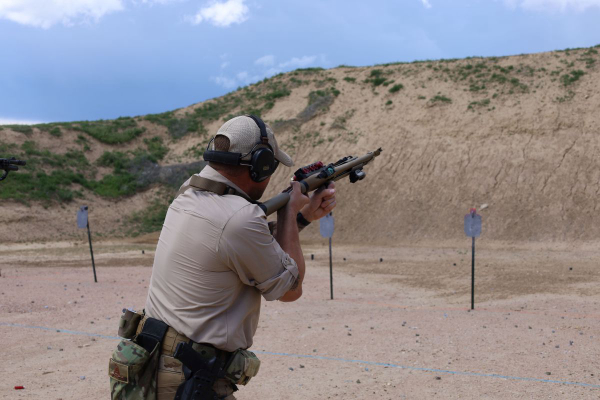

The first day ended with a trip to the Longmont, Colorado PD indoor range for a lesson on shooting in the dark and with the use of auxiliary light. Day two was back at Great Guns’ outdoor range with extensive work with slugs and the protocol of swiftly and smoothly switching from slugs to buckshot (or vice versa) during a firefight. Practicing the maneuver and a subsequent, timed, box drill helped to reinforce to the class that manipulating a fighting shotgun is not an intuitive endeavor.
Interspersed in Watt’s instruction are pithy aphorisms designed to kick-start the thought process and challenge paradigms that shooters develop along the way.
-- “A shot clock is not a measure of performance, it's a measure of improvement.”
-- "Speed will not build technique but technique will build speed.”
-- “If you control the throttle you don’t have to hammer the brakes.”
-- “We shoot what we know, not what we think.”
Throw in a quick quote by Watt of the poem “Invictus” (“I am the master of my soul”) and you understand that the ambience of his training is as much mental discipline as it is physical manipulation.
Due to the quantity of information and practice that Watt provides, his two-day class provides a superb return on investment of a student’s time, money and effort. For information about classes available from Watt, contact him at randy@srwsplops.com.
Greg Moats was one of the original IPSC Section Coordinators appointed by Jeff Cooper shortly after its inception at the Columbia Conference. In the early 1980’s, he worked briefly for Bianchi Gunleather and wrote for American Handgunner and GUNS. He served as a reserve police officer in a firearms training role and was a Marine Corps Infantry Officer in the mid-1970’s. He claims neither snake-eater nor Serpico status but is a self-proclaimed “training junkie.”